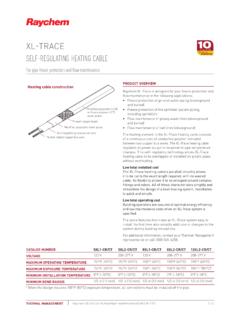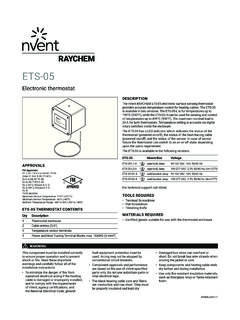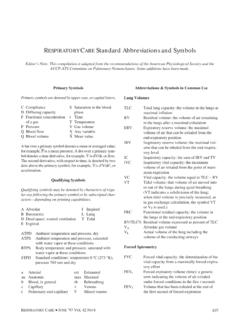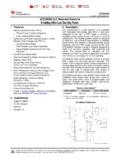Transcription of Raychem HWAT System Installation and Operation …
1 HWAT SystemInstallation and Operation Manual for nVent Raychem Hot Water Temperature Maintenance Systems for Thermally Insulated Pipesii | Safeguards and Warnings WARNING: FIRE AND SHOCK HAZARDnVent Raychem HWAT Systems must be installed correctly to ensure proper Operation and to prevent shock and fire. Read these important warnings and carefully follow all the Installation instructions. To minimize the danger of fire from sustained electrical arcing if the heating cable is damaged or improperly installed, and to comply with nVent requirements, agency certifications, and national electrical codes, ground-fault equipment protection must be used on each heating cable branch circuit. Arcing may not be stopped by conventional circuit breakers. Approvals and performance are based on the use of nVent parts only. Do not substitute parts or use vinyl electrical tape.
2 Bus wires will short if they contact each other. Keep bus wires separated. Connection kits and heating cable ends must be kept dry before and during Installation . The black heating cable core is conductive and can short. They must be properly insulated and kept dry. Damaged bus wires can overheat or short. Do not break bus wire strands when preparing the cable for connection. Damaged heating cable can cause electrical arcing or fire. Do not use metal attachments such as pipe straps or tie wire. Use only nVent approved tapes and cable ties to secure the cable to the pipe. Do not attempt to repair or energize damaged cable. Remove damaged cable at once and replace with a new length using the nVent Raychem RayClic-S splice kit. Replace damaged connection kits. Use only fire-resistant insulation which is compatible with the application and the maximum exposure temperature of the System to be | iiiTable of Contents1 General Information Use of the Manual Safety Guidelines Typical HWAT System Electrical Codes Approvals Warranty Trade Coordination General Installation Notes Tools Required 62 Heating Cable Verification and Selection Heating Cable 73 Heating Cable Installation Heating Cable Storage Pre- Installation Checks Installation 84 Heating Cable Components General Connection Kit Information 145 Control and Monitoring HWAT-ECO and ACCS-30 Controllers 166 thermal Insulation Insulating the System Insulation Installation 177 Power Supply and Electrical Protection Voltage Rating Circuit Breaker Sizing Electrical Loading Ground-Fault Protection 218 Commissioning and
3 Preventive Maintenance Tests Preventative Maintenance 24iv | Test Procedures System Tests Fault Location Tests Cable and Connection Continuity10 Test Procedures 3411 Troubleshooting Guide | Use of the ManualThis Installation and Operation manual is for Raychem HWAT Hot Water Temperature Maintenance systems installed on thermally insulated pipes only. This manual details how to install and operate an HWAT System . The HWAT System includes the HWAT-R2 heating cables, RayClic connection kits, and the nVent Raychem HWAT-ECO or ACS-30 controllers. It is important to review this manual and the following documents with the installing contractor: HWAT System Product Selection & Design Guide (H57538) HWAT-ECO Data Sheet (H57339) ACS-30 Mulitpoint Commercial heat-tracing Control System Data Sheet (H58261) HWAT Heating Cable Data Sheet (H57512) RayClic Connection System Data Sheet (H57545) HWAT-ECO Installation and Operation Manual (H57340) ACS-30 Programming Guide (H58692)For additional information, contact:nVent7433 Harwin Drive Houston, TX 77036 USA Tel: + : + : + : Important: For the nVent warranty and agency approvals to apply, the instructions that are included in this manual and product packages must be followed.
4 General Information12 | General Safety GuidelinesThe safety and reliability of any heat-tracing System depends on the quality of the products selected, and on proper design, Installation , and maintenance. Incorrect design, handling, Installation , or maintenance of any of the System components can cause underheating or overheating of the pipe, or damage to the heating cable System , and may result in System failure, electric shock, or fire. The guidelines and instructions contained in this guide are important. Follow them carefully to minimize these risks and to ensure that the HWAT System performs special attention to the following: Instructions marked Important Warnings marked Typical HWAT SystemA typical HWAT System is shown is Figure 1. The heating cable is cut to length in the field and is attached to the pipe with glass tape. A power connection kit connects the heating cable bus wires to power in a junction box.
5 RayClic tees and splices accommodate pipe branches to connect two or three heating cables together. An end seal kit is used to terminate the end of the heating cable. A controller is used to set the maintain temperature and improve energy | 3 General Information1 SpliceTo powerdistributionpanelNote: Partial pipe insulation shown here for pipes must be fully insulatedEnd sealTeeThermalinsulationHeatingcablePipe temperaturesensorTemperaturesensorHeatin gcableInsulationGlasstapePowerconnection ControllerTo BMSETL label180 Figure 1: Typical HWAT heating cable Electrical CodesSection 427 of the National Electrical Code (NEC), and Part 1, Section 62 of the Canadian Electrical Code (CEC), in particular, govern the Installation of electrical heat-tracing systems used on hot water pipes. All installations must be in compliance with this and any other applicable national or local ApprovalsHWAT-R2 heating cable and RayClic connection kits, are UL Listed and CSA certified for use in non-hazardous locations.
6 The HWAT-ECO controller is c-UL-us Listed and the ACS-30 controller is c-CSA-us certified (ACS-UIT) and c-UL-us Listed (ACS-PCM2-5) to US and Canadian standards for us in non-hazardous locations. Refer to the specific product data sheets for | General WarrantynVent standard limited warranty applies to all products. An extension of the limited warranty period to ten (10) years from the date of Installation is available if a properly completed on-line warranty form is completed within (30) days from the date of Installation . The extension is valid for the HWAT-R2 heating cable, RayClic connection kits and accessories, but not the HWAT-ECO or ACS-30 controllers. You can access the complete warranty on Trade CoordinationInstallation of an HWAT System can involve or impact the work of numerous trades. Therefore, effective and early coordination between trades is a critical aspect of all HWAT System Installations.
7 The Installation of the heating cable and connections must be properly scheduled, along with the scheduling of the risers and insulation Installation . This guide will assist the installer throughout the Installation process and must be reviewed by all affected trades before Installation of the HWAT System begins. In a fast-track job, the HWAT System must be considered a critical path item: the pipe, heating cable, insulation, and wallboard must all be installed in the proper order, since the heating cable cannot be installed later. If, for example, the walls go up before the heating cable commissioning tests have been completed, it may be necessary to remove the walls in order to repair a damaged or improperly installed System . Ensuring that the Installation of the HWAT System is included in the overall construction schedule will help ensure a successful and trouble-free | General Installation NotesRead and observe the instructions in this guide to insure that the HWAT System is installed successfully.
8 Accidental damage to the System can be minimized during construction by installing thermal insulation on the pipe immediately after the pipe has been traced and the heating cable has been tested. Read all Installation documentation to familiarize yourself with the System components. Read and follow all warnings and recommendations. All involved trades should review this entire guide and assess the recommendations applicable to their scope of work. All heat-traced pipes and equipment must be thermally insulated. Insulation is an important part of the HWAT System . For an effective System , the fiberglass insulation must be a specific thickness for each specific pipe size as detailed in Table 2 on page 17. Do not install the HWAT System below the minimum Installation temperature. The minimum Installation temperature for HWAT heating cables is 0 F ( 18 C) The minimum Installation temperature for HWAT-ECO is 40 F (5 C).
9 Ensure that your water heater temperature is set at your desired pipe maintain temperature. Do not energize cable when it is coiled or on the reel. Never use metal tie wire or pipe straps to secure heating cables to : Exceeding 185 F (85 C) for HWAT-R2 will decrease the power output of the heating cables over time. General Information16 | Tools RequiredFor installing cable and connection kits: Utility knife Diagonal cutters Cable cutters Tape measure Screwdriver Heat gun or propane torchFor testing the heating cable: Megohmmeter 2500 Vdc Multimeter (voltage, resistance and capacitance) General | 7 Heating Cable Verification and Heating CableThe HWAT System includes HWAT-R2 heating cable designed to maintain the piping at specific temperature settings with the use of the HWAT-ECO or ACS-30 controllers. Figure 2 shows the construction of the heating copper bus wiresSelf-regulating conductive corePolymer-coated aluminum wrapTinned-copper braidModified polyolefinouter jacketModified polyolefin inner jacketFigure 2: HWAT-R2 heating cableThe minimum control setpoint for HWAT-R2 is 105 F (40 C).
10 The maximum control setpoint for HWAT-R2 is 140 F (60 C). 8 | Heating Cable Heating Cable Storage Store the heating cable in a clean, dry location. Temperature range: 0 F ( 18 C) to 140 F (60 C). Protect the heating cable from mechanical Pre- Installation ChecksCheck materials received: Review the heating cable design and compare the list of materials to the catalog numbers of the heating cables and connection kits received to confirm that the proper materials are on site. The heating cable type is printed on its jacket. The HWAT System is limited to 208 V or 240 V service when using the HWAT-ECO controller. When using the ACS-30 controller the voltage range is 208 277 V. Ensure that the service voltage available is correct. Inspect the heating cable and connection kits to ensure there is no in-transit damage. Verify that the heating cable jackets are not damaged by conducting the insulation resistance test (refer to Section 9) on each reel of cable.












